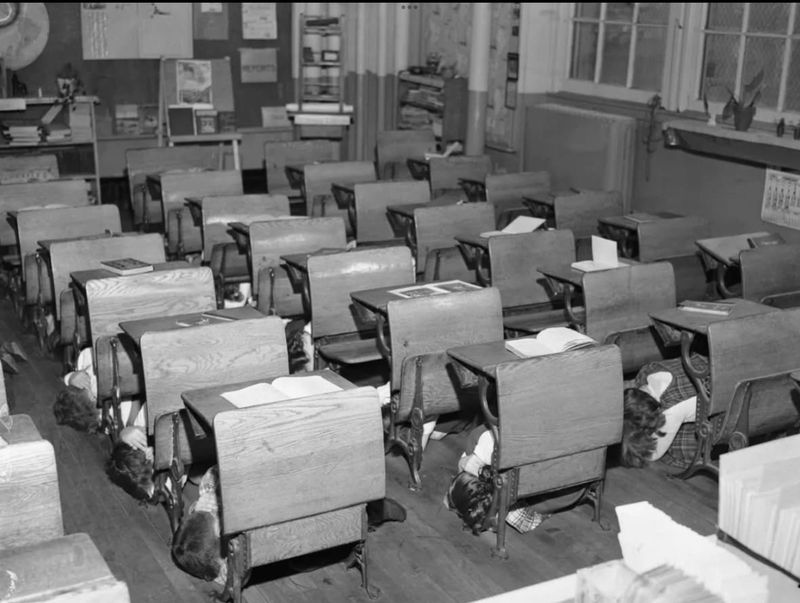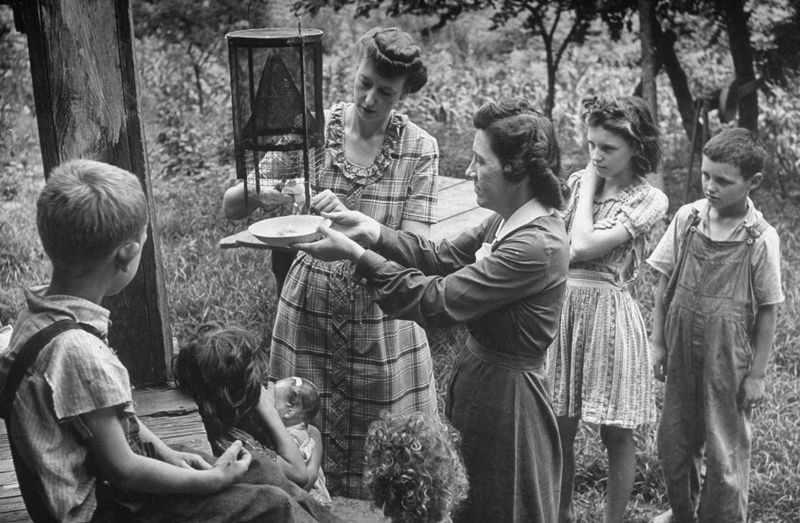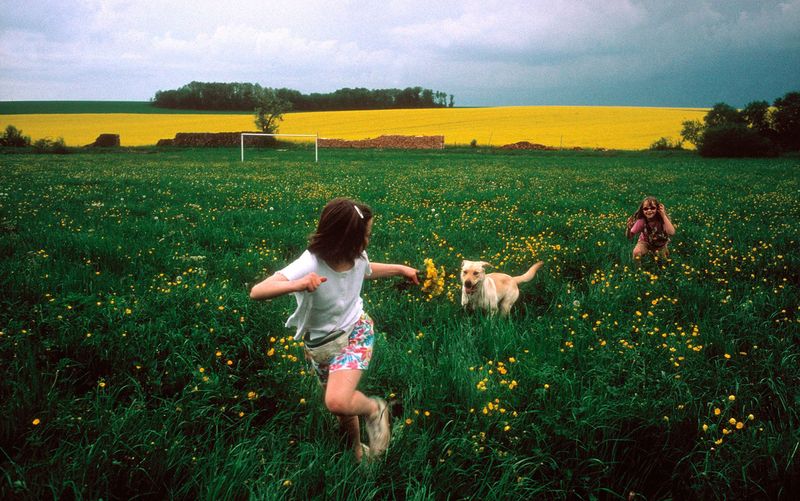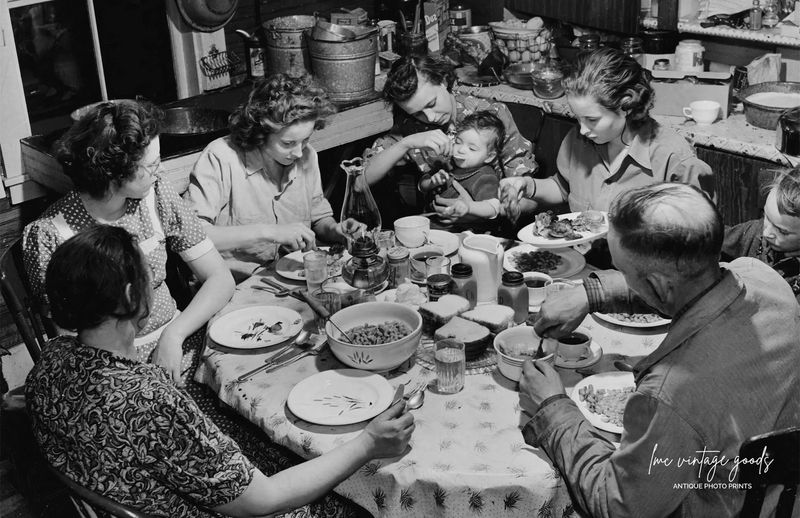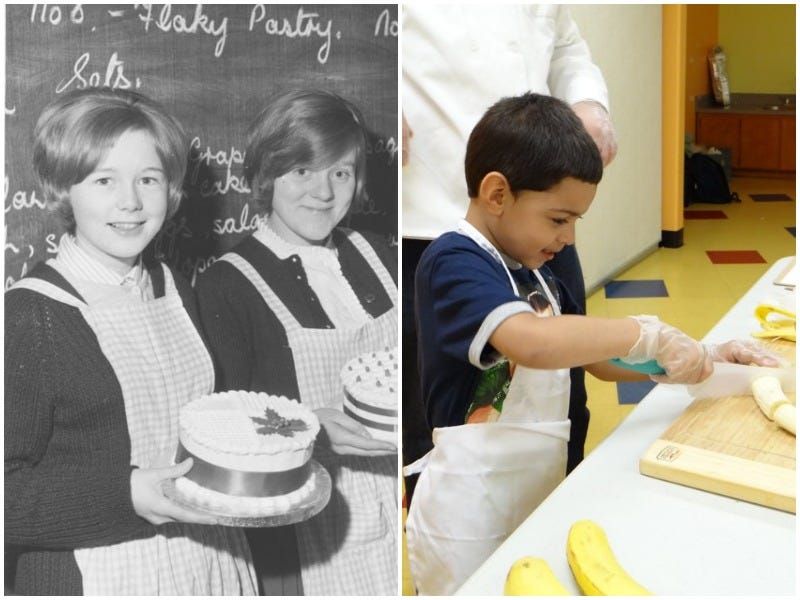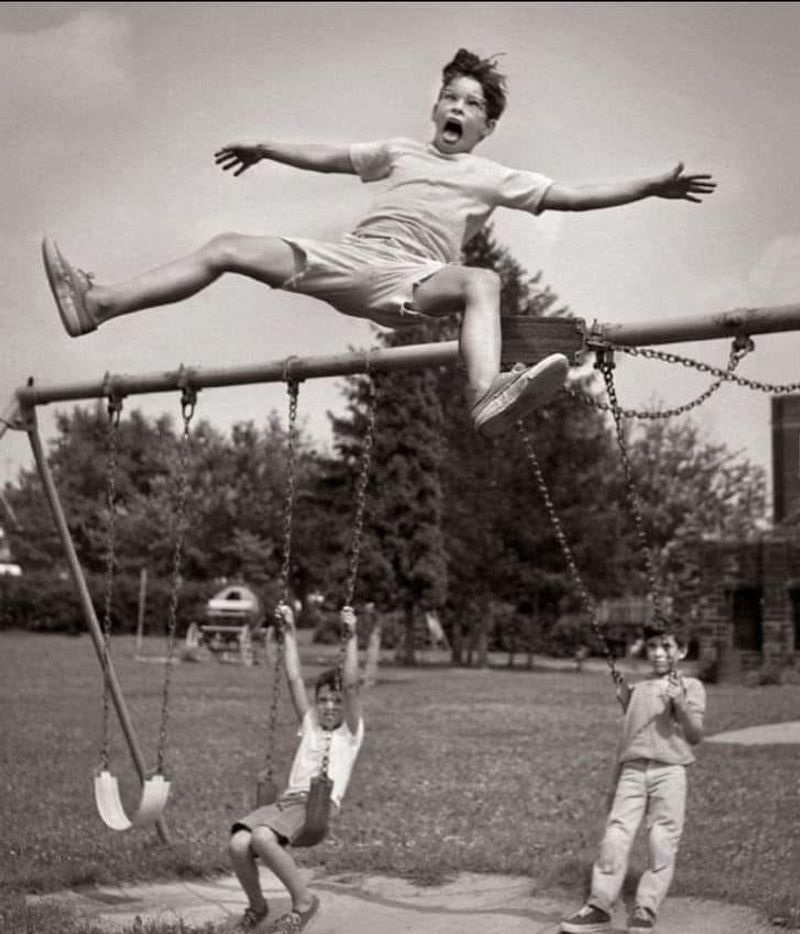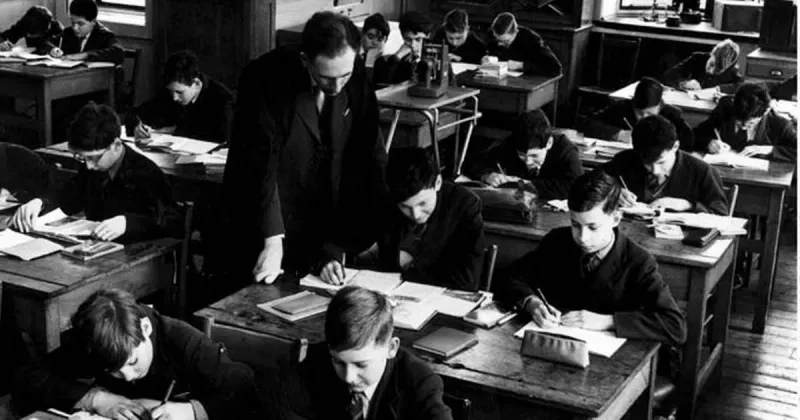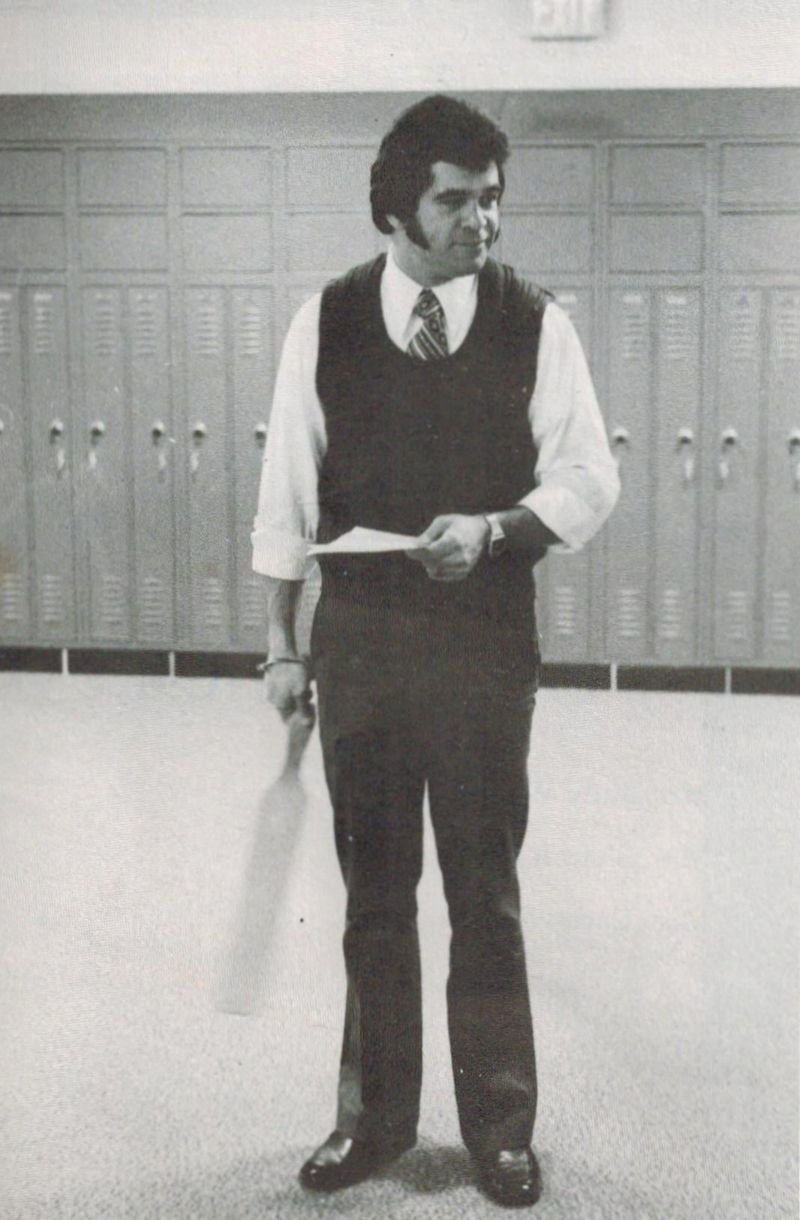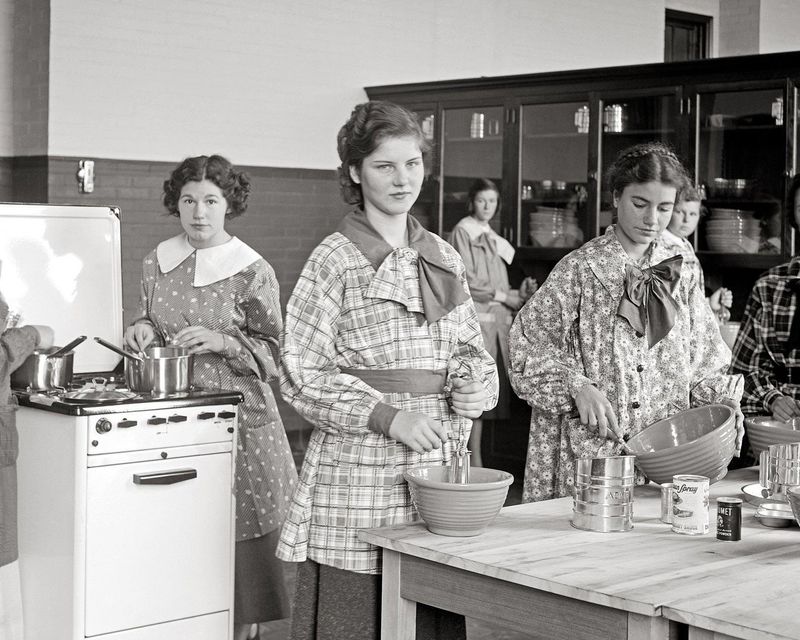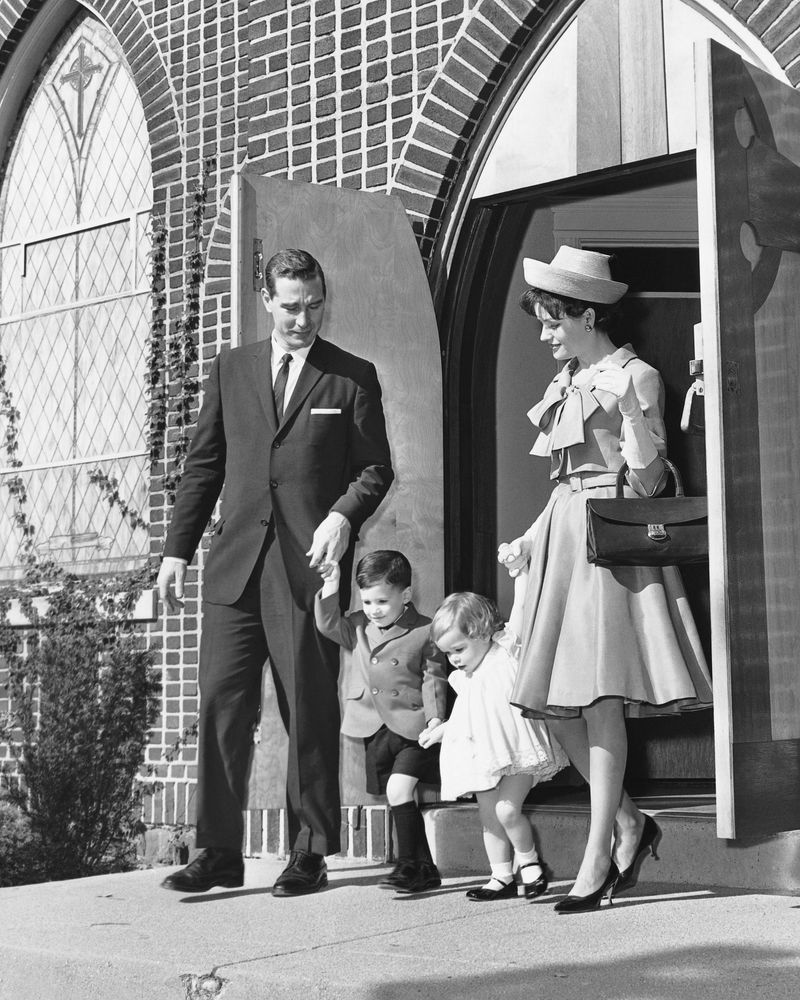The 1950s was a very different time for growing up. After World War II, America embraced traditional values, strict discipline, and a hands-off parenting style that would raise eyebrows today. Parents and teachers had different priorities back then, focusing on independence, respect for authority, and preparing children for a world that no longer exists.
1. Duck and Cover Nuclear Drills
Crouching beneath wooden desks, children practiced surviving atomic bombs as casually as today’s kids practice fire drills. Schools distributed comic books featuring Bert the Turtle demonstrating how to “duck and cover” when the bright flash appeared.
At home, families built backyard fallout shelters stocked with canned goods and board games. The looming threat of nuclear war wasn’t shielded from children—it was incorporated into their daily routines.
Kids memorized evacuation routes and identified civil defense symbols with the same ease they learned their ABCs.
2. Unsupervised Kindergarten Commutes
Five-year-olds navigated neighborhood streets completely alone, rain or shine. Parents simply pointed out the route once or twice, then expected their little ones to handle the journey independently thereafter.
Morning goodbyes happened at the front door, not the school entrance. Children crossed busy intersections, passed through unfamiliar neighborhoods, and solved problems without adult intervention.
This wasn’t considered neglectful—it was standard practice. The community functioned as a collective guardian, with neighbors keeping casual watch over all children passing through.
3. Strict Financial Discipline
Allowances were tiny by today’s standards—often just 25 to 50 cents weekly. Children learned patience through mandatory saving, sometimes waiting months for desired toys.
Parents didn’t rush to fulfill wishes. “Christmas and birthdays” became the standard response to requests for new possessions. Piggy banks weren’t just cute decorations but serious financial institutions for young savers.
Kids tracked their coins in little notebooks, calculating how many lawns needed mowing before affording that coveted baseball glove. Instant gratification wasn’t part of the vocabulary.
4. Ruthless Table Manners Enforcement
Elbows off the table wasn’t just a suggestion—it was law. Children who failed to use proper utensils or chewed with open mouths faced immediate correction, sometimes mid-bite.
Formal dining etiquette started young. Boys pulled out chairs for females, napkins stayed in laps, and “please pass the potatoes” replaced pointing or reaching. Leaving the table required permission, even for bathroom breaks.
Families ate together every night without distractions, creating the perfect laboratory for manners training. These lessons weren’t confined to home—other adults freely corrected children’s table behavior without parental permission.
5. Forced Right-Handedness
Left-handed children faced systematic retraining. Teachers tied left hands to desk chairs or rulers slapped knuckles when the “wrong” hand reached for pencils.
Parents worried about everything from academic struggles to moral character flaws supposedly linked to left-handedness. Special remediation tools like awkward right-handed scissors and rigid penmanship guides frustrated naturally southpaw children.
The practice stemmed from outdated beliefs connecting left-handedness to stubbornness, clumsiness, or even devilish tendencies. Children internalized that their natural inclinations were somehow defective and needed correction.
6. Children Should Be Seen, Not Heard
Adults conducted conversations as if children weren’t present. Young ones learned to sit quietly during visits, never interrupting adult discussions regardless of how long they lasted.
Speaking without being directly addressed first was considered rude and disrespectful. Children who chattered excessively received sharp looks or were sent from the room.
This silence training started early. Even toddlers were expected to play quietly while adults talked, developing almost supernatural patience by today’s standards. The ability to remain invisible while physically present was considered a valuable childhood skill.
7. Formal Social Skills Training
Seven-year-olds practiced formal introductions with proper titles: “Mrs. Johnson, may I present my friend Billy.” Children were drilled on handshake technique—firm grip, eye contact, two pumps maximum.
Girls learned to serve tea properly while boys practiced holding doors. Thank-you notes weren’t optional—they were mandatory written exercises following every gift or dinner invitation.
Phone etiquette included answering with “Smith residence, Johnny speaking” rather than casual hellos. Children rehearsed these skills through role-play with parents before real-world application, treating social graces as seriously as academic subjects.
8. All-Day Outdoor Unsupervised Play
Summer mornings began with mothers shooing children outside after breakfast with simple instructions: “Be home when the streetlights come on.” Kids roamed neighborhoods, explored woods, and waded through creeks without adult supervision for hours.
Children created their own entertainment, building forts from scrap lumber or organizing neighborhood-wide games. They managed conflicts, assessed risks, and solved problems without adult intervention.
Parents had no idea exactly where their children were for most of the day. No cell phones, no check-ins, no GPS tracking—just a dinner deadline and an assumption of basic common sense.
9. Clean Plate Guilt Tactics
Dinner plates became moral battlegrounds. Children stared down unwanted liver or canned spinach while parents invoked starving children in faraway countries.
Food waste was considered almost sinful in post-war America. Kids couldn’t leave the table until plates were empty, sometimes sitting for hours in standoffs over cold vegetables.
Picky eating wasn’t accommodated with special meals. The family ate one menu, period. Parents used serving spoons to place food directly on children’s plates, eliminating choice in portions or preferences. Complaining about dinner was considered deeply ungrateful.
10. Gender-Based Education Tracks
School curricula separated by sex seemed perfectly logical. Girls disappeared into home economics classrooms to master meatloaf recipes and buttonhole stitching while boys hammered away in woodshop.
Elementary schools practiced different playground activities for each gender. Boys played competitive sports while girls learned jump-rope rhymes and hopscotch patterns.
Career guidance reinforced these divisions. Guidance counselors directed boys toward business, trades or professions while steering girls toward secretarial work, nursing, or teaching—all considered appropriate until marriage and motherhood. Crossing these boundaries required exceptional determination and parental advocacy.
11. Walking Off Injuries
Scraped knees and bloody noses rarely warranted medical attention. Parents casually instructed children to “shake it off” or “rub some dirt on it” before sending them back to play.
First aid consisted of quick rinses under cold water and maybe a bandage for truly impressive wounds. Minor fractures sometimes went undiagnosed until persistent complaints finally warranted doctor visits.
This wasn’t considered neglect but character building. Children learned to assess their own pain thresholds and developed resilience through minimally treated mishaps. Tears were discouraged, especially for boys who heard “big boys don’t cry” from earliest childhood.
12. Absolute Respect for Authority
Questioning adult decisions was unthinkable. Teachers’ judgments were final—if you got in trouble at school, you faced double punishment at home.
Police officers, principals, neighbors, and even teenage babysitters wielded authority that children were expected to obey without hesitation. Parents backed other adults’ decisions automatically, creating a unified authority front.
Children addressed all adults as “Mr.” or “Mrs.” regardless of familiarity. The phrase “because I said so” ended discussions immediately. This authority extended to physical discipline, with teachers and principals administering corporal punishment without requiring parental notification.
13. Physical Discipline Without Question
Spanking wasn’t controversial—it was standard practice. Children who misbehaved might hear “wait until your father gets home” or face immediate consequences with wooden spoons, belts, or bare hands.
Schools maintained paddles prominently displayed in principals’ offices. Permission slips for corporal punishment didn’t exist—physical discipline was considered the school’s prerogative.
Children rarely reported these punishments to authorities because no one would have considered them abuse. Parents openly discussed discipline techniques, often comparing notes on effectiveness. The common belief held that physical punishment built character and moral fiber.
14. Preparing Girls for Homemaking
Female education prioritized future domestic roles above career preparation. Girls received toy vacuum cleaners and kitchen sets while their brothers got chemistry kits and model rockets.
Home economics classes taught teenage girls to prepare three-course meals, properly iron men’s shirts, and manage household budgets. These weren’t electives but required courses for female students.
Magazines, books and educational films reinforced these expectations with titles like “How to Be a Good Wife.” Girls learned that their highest achievement would be creating comfortable homes for future husbands and children, with personal ambitions considered secondary or even selfish.
15. Mandatory Religious Participation
Sunday mornings weren’t negotiable. Children attended services regardless of interest level, dressed in uncomfortable formal clothes reserved specifically for worship.
Religious education extended beyond weekends. Many children participated in additional weekday religious instruction, memorizing texts and doctrines. Public schools often incorporated prayer and religious references into daily activities.
Questioning religious teachings was discouraged as disrespectful. Children who expressed doubts faced serious conversations about faith and obedience. Alternative religious views received little acknowledgment, with most communities expecting conformity to the dominant local denomination.

